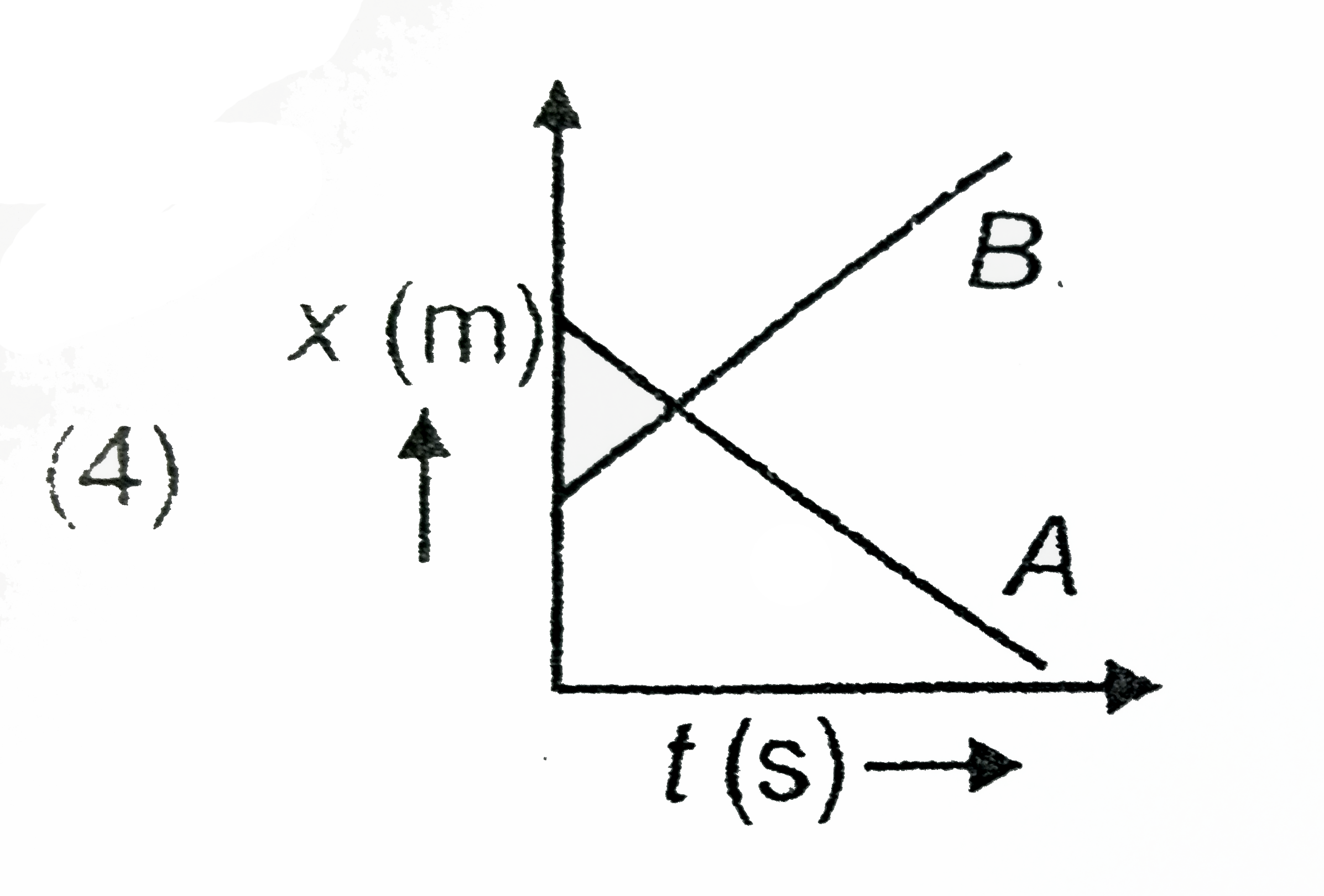Two objects A and B are moving with velocities vAandvB respectively along positive x-axis. If vA<vB then, which of the following position-time graphs is correctly showing the velocity of A and B ?




The correct Answer is:B
To solve the problem, we need to analyze the motion of two objects A and B moving along the positive x-axis with different velocities. Given that vA<vB, we can deduce the following:
Step 1: Understanding the Concept of Position-Time Graphs
Position-time graphs represent the position of an object as a function of time. The slope of the position-time graph indicates the velocity of the object. A steeper slope means a higher velocity.
Step 2: Analyzing the Velocities
Since vA<vB:
- Object A will have a smaller slope on the position-time graph compared to object B.
- Object B will have a steeper slope, indicating that it is moving faster than object A.
Step 3: Drawing the Graphs
1. Graph for Object A: Since it has a lower velocity, the line representing its position over time will be less steep.
2. Graph for Object B: Since it has a higher velocity, the line representing its position over time will be steeper.
Step 4: Comparing the Graphs
When looking at the position-time graphs:
- The line for object A should be less steep than the line for object B.
- Both lines should start from the same point if they start at the same time, but the line for B will rise more sharply than the line for A.
Conclusion
The correct position-time graph will show two lines where the line for object A is less steep than the line for object B, confirming that vA<vB.
Position-time graphs represent the position of an object as a function of time. The slope of the position-time graph indicates the velocity of the object. A steeper slope means a higher velocity.
Since vA<vB:
- Object A will have a smaller slope on the position-time graph compared to object B.
- Object B will have a steeper slope, indicating that it is moving faster than object A.
1. Graph for Object A: Since it has a lower velocity, the line representing its position over time will be less steep.
2. Graph for Object B: Since it has a higher velocity, the line representing its position over time will be steeper.
When looking at the position-time graphs:
- The line for object A should be less steep than the line for object B.
- Both lines should start from the same point if they start at the same time, but the line for B will rise more sharply than the line for A.
The correct position-time graph will show two lines where the line for object A is less steep than the line for object B, confirming that vA<vB.
Topper's Solved these Questions
- MOTION IN STRAIGHT LINEBook:AAKASH INSTITUTEChapter:MOTION IN STRAIGHT LINEExercise:Assignment (SECTION - B)
Explore 19 Videos
- MOTION IN STRAIGHT LINEBook:AAKASH INSTITUTEChapter:MOTION IN STRAIGHT LINEExercise:Assignment (SECTION - C)
Explore 7 Videos
- MOTION IN STRAIGHT LINEBook:AAKASH INSTITUTEChapter:MOTION IN STRAIGHT LINEExercise:Try Yourself
Explore 40 Videos
- MOTION IN A STRAIGHT LINEBook:AAKASH INSTITUTEChapter:MOTION IN A STRAIGHT LINEExercise:ASSIGNMENT (SECTION - D)
Explore 15 Videos
- MOVING CHARGE AND MAGNESIUMBook:AAKASH INSTITUTEChapter:MOVING CHARGE AND MAGNESIUMExercise:SECTION D
Explore 16 Videos
Similar Questions
Velocity of light ray in two media A and Bare v1andv2 respectively.
If vB=1.5VA, then which medium is denser?
View SolutionTwo particles A and B are moving with constant velocities V1=ˆj and v2=2ˆi respectively in XY plane. At time t=0, the particle A is at co-ordinates (0,0) and B is at (-4,0). The angular velocities of B with respect to A at t=2s is (all physical quantities are in SI units)
View Solution
Knowledge Check
Two objects A and B are moving in opposite directions with velocities vAandvB respectively, the magnitude of relative velocity of A w.r.t. B is
AvA−vBBvA+vBCvB−vADvA/vBIn fig., blocks A and B move with velocities v1 and v2 along horizontal direction. Find the ratio of v1/v2
 Asinθ1sinθ2Bsinθ2sinθ1Ccosθ2cosθ1Dcosθ1cosθ2
Asinθ1sinθ2Bsinθ2sinθ1Ccosθ2cosθ1Dcosθ1cosθ2Which of the following position-time graphs correctly represents two moving objects A and B with zero relative velocity ?
A B
B C
C D
D
Two projectile A and B located at (0,0) and (4.4) respectively start moving simu ltaneou lsy with velocities VA=−4ˆi and VB=4ˆj:
View SolutionTwo masses mA and mB moving with velocities vA and vB in opposite direction collide elastically after that the masses mA and mB move with velocity vB and vA respectively. The ratio (mA/mB) is
View SolutionTwo particles of mass mA and mB and their velocities are VA and VB respectively collides. After collision they interchanges their velocities, then ratio of mAmB is
View SolutionFor two gases A and B with molecular weights MA and MB, respectively, it is observed that at a certain temperature T, the mean velocity of A is equal to the Vrms of B. Thus, the mean velocity of A can be made equal to the mean velocity of B, if
View SolutionTwo particles A and B locat at (0,0) and (4,4) respectively start moving simu lataneou ly with velocities vA=−4ˆi and VB=−4ˆj:
View Solution

